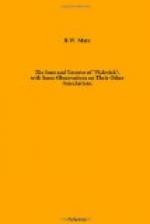[illustration: The George Inn, Southwark, in 1858. From an engraving by Fairholt]
“I, however, had the opportunity of comparing both inns some years ago, and have no hesitation in saying that the ‘George’ is the inn where the irrepressible Alfred Jingle and the elderly Miss Rachel were discovered by the warm-hearted, hot-tempered Wardle. If you like to go upstairs you can see the very room where Mr. Jingle consented to forfeit all claims to the lady’s hand for the consideration of a hundred and twenty pounds. Cannot you fancy, too, the landlord shouting instructions from those picturesque flower-decked galleries to Sam in the yard below?”
These deductions and views are not in any way convincing to us; indeed, we find ourselves in complete disagreement with them, and few Dickensians, we feel sure, will endorse them.
Mr. Ashby Sterry’s argument regarding the “Bull” and the “Blue Boar” at Rochester proves nothing. Dickens described the “Bull” there in The Pickwick Papers and called it the “Bull” at Rochester, as he did the “Leather Bottle” at Cobham, the “Angel” at Bury St. Edmunds, the “Great White Horse” at Ipswich—to name a few parallel cases. When he described the “Bull” and called it the “Blue Boar,” it was in another book, Great Expectations, not in Edwin Drood, as stated by Mr. Ashby Sterry, and its location was a fictitious city, i.e. The Market Town.
The only case in which Dickens deliberately used the name of one inn for another was that of the “Maypole” and “King’s Head” at Chigwell in Barnaby Rudge. But in this instance he admitted that he had done so, although it was scarcely necessary, for the inns were very dissimilar and the novelist’s description of the latter could not be taken for the former.
The case of the “George” and the “White Hart” is different. They both stood quite near to each other at the time Dickens was writing The Pickwick Papers, and were both so named and both famous. There could be no reason, therefore, for him to describe one and call it by the other’s name.
Although they may not have been identical in all particulars as to structure, the “George” and the “White Hart” were sufficiently alike to make it possible for a person of imagination to go over the “George” and be satisfied that such and such a room might do for the one in which “Mr. Jingle forfeited all claims to the lady’s hand,” and imagine, too, that the galleries could be accepted easily as those over which “the landlord shouted instructions to Sam in the Yard.” But these flights of fancy could be indulged in even n the New Inn, Gloucester, or any similar old coaching inn, if one so desired.
Mr. Percy FitzGerald, the greatest authority on The Pickwick Papers, is of the same opinion as ourselves on the point, and asks: “Why should notoriety be attached to the ‘White Hart,’ from which the ‘George’ was to be shielded?”
No, the “George” is a wonderfully alluring old inn, and for this reason Dickensians have a warm place in their hearts for it. But we have no hesitation in saying that it is not the original of the “White Hart” of Pickwick and Sam Weller fame.




